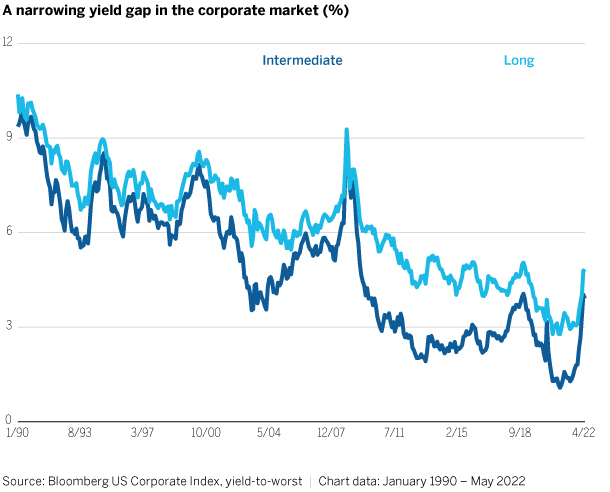- Fixed Income Portfolio Manager
Skip to main content
- Funds
- Insights
- Capabilities
- About Us
- My Account
The views expressed are those of the author at the time of writing. Other teams may hold different views and make different investment decisions. The value of your investment may become worth more or less than at the time of original investment. While any third-party data used is considered reliable, its accuracy is not guaranteed. For professional, institutional, or accredited investors only.
US fixed income markets have experienced their worst ever start to a calendar year as Federal Reserve (Fed) tightening in response to persistent inflation pressures has shifted the US Treasury yield curve flatter and higher. Credit spreads have widened sharply amid the expected slowdown in economic activity brought on by tighter financial conditions and exacerbated by higher commodity prices following the Russian invasion of Ukraine. But while it has been a painful start to the year for credit investors, yields are now at post-global financial crisis (GFC) highs, and I believe forward-looking return prospects now look much more reasonable. Specifically, I think the intermediate segment of the corporate market is potentially offering some of the most attractive opportunities.
Extraordinarily accommodative Fed policy enacted in response to the pandemic pushed bond yields to record lows. With the Fed now reversing course, credit investors are asking, “Where do we go from here?” While I’m not attempting to call the peak in yields, futures markets have moved substantially since the start of the year, reflecting expectations of an additional 200 basis points (bps) of Fed hikes in 2022 and further increases in US Treasury yields to around 3% across most of the curve. From my perspective, a number of factors suggest yields could soon begin to stabilize, including moderating inflation due to base effects and the lagged impact of higher mortgage rates, weaker growth from tighter monetary policy, and expected stronger demand for fixed income at higher yields. As the yield curve has flattened, the gap between long and intermediate corporate yields has narrowed (Figure 1).

As of the end of May, intermediate corporate bonds yielded close to 4% and the spread on the Bloomberg Intermediate Corporate Index was at 112 bps, in the 60th percentile versus history, dating back to January 1990. This looks like the sweet spot of the curve to me, given that investors are not yet compensated enough to extend duration due to the uncertainty that remains with respect to inflation and with the yield between intermediate and long corporates historically narrow. Intermediate corporate yields would need to rise by 89 bps over one year to generate a negative total return. This compares to a 30 bps cushion a year ago. Said another way, income for intermediate corporates today is far more attractively priced than it was last year.
Corporate leverage declined in 2021 as companies paid down debt incurred during the pandemic and EBITDA recovered. Despite all the volatility this year, it’s important to note that corporate balance sheets came into the year in a very strong position, which can help to weather the storm. I do expect M&A and shareholder-friendly activity to pick up this year, which could lead to a modest deterioration in fundamentals. But I think most companies, having just experienced the effects of the pandemic, are aware of the importance of a strong balance sheet. It seems likely that the bulk of M&A activity would be executed in the context of maintaining current ratings, though there may be some exceptions.
In this environment, I think there’s a case for being more selective in industrials and favoring financials and utilities. Industrials appear more likely than financials and utilities to be opportunistic in the use of their balance sheet. US bank credit profiles have become more defensive over time, given the rise in regulatory oversight, and I think they’re likely to exhibit more stable fundamentals as a result. I also expect utilities to behave defensively in an economic slowdown. Both utilities and financials are trading at attractive levels compared to industrials on a historical basis. I am less concerned about the vulnerability of banks to a recessionary environment compared to the global financial crisis, given higher capital requirements for the sector.
With funded ratios hovering around 100%, many corporate defined benefit plans continue to move money from return-seeking allocations into liability-hedging allocations. Intermediate credit could play a key role at the next derisking trigger — either because a plan is closed and its duration is declining every year or because it has a large liability-hedging allocation and no longer needs capital-efficient sources of duration and spread duration to hedge liabilities. This could favor intermediate credit flows and support the market from a technical perspective. This is also happening at a time when the intermediate part of the index has been shrinking relative to the long segment. Said another way, in 2018 most LDI flows that materialized were focused on long credit. With plans better funded and more hedged, we think those flows may be more balanced between intermediate and long, with intermediate growing in importance over time.
The attractive yields/spreads in the intermediate market may not last. I expect the pace of new issuance to slow over the balance of this year as borrowing costs have risen sharply and given that the economic and geopolitical outlooks are more clouded. Many companies took advantage of receptive capital markets over the last two years to lock in low borrowing costs and term out their debt. Companies that do come to market are likely to pay spread concessions of around 20 bps, which could present attractive opportunities in credits.
I continue to believe that further bouts of market volatility will generate greater idiosyncratic dispersion and inefficiencies in the pricing of risk. I also think there is a case for a slightly defensive credit risk posture and a liquidity buffer to pursue opportunities amid any dislocations.

LDI in 2026: 10 questions corporate plan sponsors are asking
Continue readingCorporate versus credit indices: What’s the best match for liability-driven investing?
Continue readingAllocating to alternatives: A role-based guide for corporate DB plans
Continue readingSetting ROAs for 2025: A guide for US corporate and public plans
Continue readingWhy more corporate plans should pass on pension risk transfers
Continue readingPrivate placements: A primer for corporate DB plans preparing to derisk
Continue readingURL References
Related Insights
Stay up to date with the latest market insights and our point of view.

LDI in 2026: 10 questions corporate plan sponsors are asking
Members of our LDI Team address a range of topics that US corporate plans will be thinking about in 2026, from benchmark choices to liability-hedging and return-seeking investment ideas.

Corporate versus credit indices: What’s the best match for liability-driven investing?
When selecting benchmarks for LDI needs, corporate DB plan sponsors often ask about the differences between investment-grade corporate and credit indices. In this paper, we compare the composition and performance of corporate and credit indices, as well as intermediate and long maturity indices, and we offer insights on choosing indices that fit a plan’s liability.

Allocating to alternatives: A role-based guide for corporate DB plans
For corporate plan sponsors thinking about weaving hedge funds and private equity into their portfolios, we offer this brief guide to the potential benefits and key considerations when establishing an allocation, including liquidity stress testing.

The high cost of unfunded duration — and some hope on the horizon
With many corporate DB plans thinking about managing their hedge ratios, members of our LDI Team explain the high cost of synthetic duration, how plans might want to think about this issue when targeting a specific duration profile, and why costs could improve over time.

Setting ROAs for 2025: A guide for US corporate and public plans
How are pension plans adjusting their ROA assumptions? And how do those assumptions line up with our long-term capital market assumptions? Find out in this annual update.

Why more corporate plans should pass on pension risk transfers
LDI Team Chair Amy Trainor explains why she believes a pension risk transfer may, in many cases, not be the best choice for fully funded plans from a cost/benefit standpoint.

Private placements: A primer for corporate DB plans preparing to derisk
With many corporate DB plans exploring derisking opportunities, Portfolio Manager Elisabeth Perenick and Multi-Asset Strategist Amy Trainor discuss the potential role that private investment-grade credit, or private placements, could play and consider common questions about liquidity and allocation sizing.

Using defensive equities in a return-seeking portfolio: A factor framework for corporate plans
Members of our LDI and Fundamental Factor teams share their views on defensive equity investments, including their role in a plan's portfolio and the current environment for defensive factors.
URL References
Related Insights